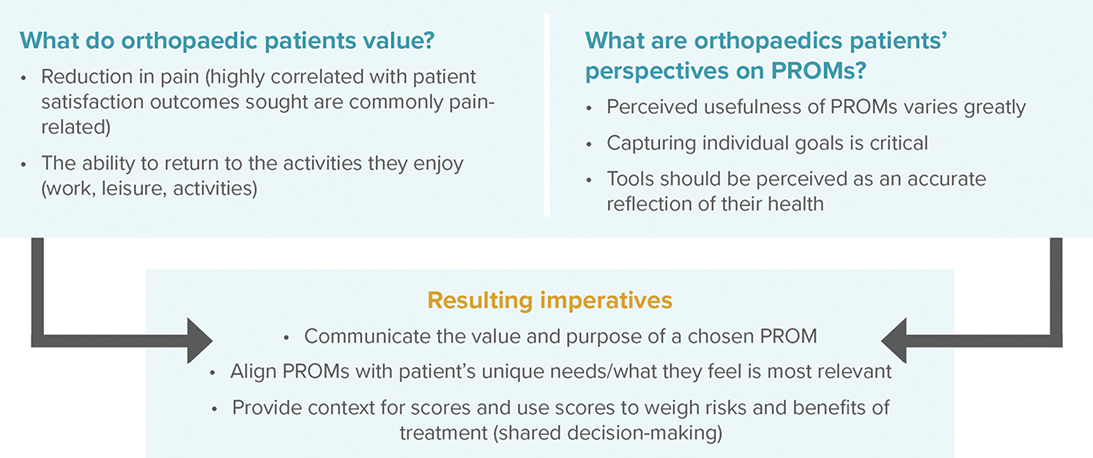
Editor’s note: This article is part of an ongoing “PROMs in Practice” series presented by the AAOS Patient-Reported Outcome Measures (PROMs) Workgroup. Each month, a workgroup member will address the impact of PROMs on their subspecialty, patient care, the future of musculoskeletal healthcare, and more.
Whether it is the retiree with knee arthritis who wants to be able to go grocery shopping without pain, the firefighter with a rotator cuff tear who wants to get back to their job, or the high school soccer player with an anterior cruciate ligament (ACL) tear who wants to return to sports, orthopaedics is about helping patients achieve their personal goals. In most cases, patients’ goals are not about life or death, but rather about improving quality of life, reducing pain, and increasing function. These goals are the “why” that prompts patients to seek orthopaedic care. Musculoskeletal conditions create pain and disability on a daily basis for millions of people and are the number one cause of adult disability in the United States.
Recently, AAOS interviewed dozens of orthopaedic patients to understand what they found important about their care. “In nearly every interview conducted, patients voiced that the single most important element …was to measure their success based on their individual goal,” according to AAOS. In general, these goals were a reduction in pain and the ability to return to activities, such as running, kneeling for gardening or worship, or working without pain (Fig. 1). Unfortunately, most patients reported that their surgeons did not address their specific goals when making the decision to have surgery. Obviously, this lack of appropriate focus can be a source of patient dissatisfaction, confusion, and potentially litigation. PROMs can be an important tool to help capture progress on patients’ goals.
How can PROMs help?
PROMs can help surgeons focus on patients’ treatment goals in several ways. First, they help articulate the nature of patients’ goals in more specific and concrete terms, helping provide specific areas to address. With the assistance of the specialty societies, AAOS has selected certain PROMs that are relevant and validated for areas that are clinically important to patients. PROMs help quantify the nature and type of pain and also capture specific functional deficits. Like lab data and vital signs, they are a way to numerically assess and track important aspects of patient care, in this case quality of life. Additionally, when surgeons capture and review PROMs during visits, they help patients feel that they are being heard and that their individual needs are being carefully evaluated and addressed.
Second, PROMs can help guide treatment choices. Using them with patients during the decision-making process can help surgeons provide realistic expectations of outcomes and balance risks and benefits. Studies have shown that preoperatively obtained PROMs can predict who will achieve meaningful improvements in pain and function after foot and ankle surgery, total knee and hip arthroplasty, ACL reconstruction, shoulder replacement, hand surgery, and spine surgery.
PROMs also provide a mechanism to track progress, focused on what is important to the patient. Nicolas Andry Award–winning work led by Judy Baumhauer, MD, MPH, FAAOS, has shown that PROMs can be easy-to-use tools to capture clinically meaningful follow-up information after surgery. These data are helpful to follow the course of patient response to treatment, can guide prognosis and the need for additional intervention, and keep patients effectively involved and engaged.
What are the patient-related benefits of collecting PROMs?
Patients are increasingly vocal about the type of care they receive, and payers and providers are becoming more focused on patient-centered care and the tracking and reporting of patient satisfaction as an outcome. One of the biggest sources of patient complaints is a lack of communication, for example “The doctor didn’t listen to me” or “The doctor didn’t care about my problem as a person.”
PROMs can help patients feel heard because they help patients feel more actively involved in the decision-making process. PROMs allow orthopaedic surgeons to track progress and demonstrate how patients’ goals are being met. Patients are, in turn, more satisfied with their treatments and their physicians, potentially resulting in multiple additional benefits, such as improved word-of-mouth referrals and greater “likeliness to refer” on patient satisfaction surveys (which can help grow a physician’s practice). Improved communication can also lead to decreased risks of misunderstandings and potential litigation.
Overall, relevant PROMs can help physicians and patients articulate and focus on specific goals, guide treatment decisions, and track relevant progress, resulting in happier patients who are more satisfied with their care—and happier physicians who helped them.
Resources developed by the PROMs Workgroup will be announced to AAOS membership as they are released and can be found at aaos.org/proms. For more information or to get involved, email proms@aaos.org.
Jason L. Koh, MD, MBA, FAAOS, FAOA, is the Mark R. Neaman Family Chair of Orthopaedic Surgery and director of the Orthopaedic and Spine Institute at Endeavor Health (formerly NorthShore University HealthSystem) in Skokie, Illinois. He is also a clinical professor at the University of Chicago, chair of the AAOS Communications Committee, and a member of the AAOS PROMs Workgroup.